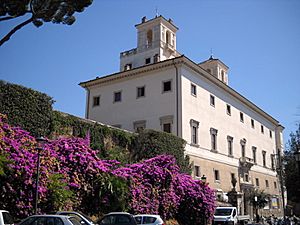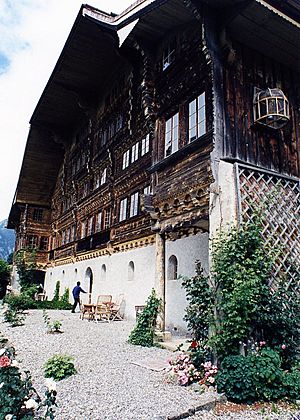Balthus facts for kids
Quick facts for kids
Balthus
|
|
|---|---|
| Balthasar Klossowski de Rola | |

Balthus by Damian Pettigrew (1996)
|
|
| Born |
Balthasar Klossowski
February 29, 1908 Paris, France
|
| Died | February 18, 2001 (aged 92) Rossinière, Switzerland
|
| Known for | Painting, drawing, watercolor |
| Awards | Praemium Imperiale |
Balthasar Klossowski de Rola (born February 29, 1908 – died February 18, 2001), known simply as Balthus, was a famous Polish-French modern artist. He was known for his unique style of painting, which often showed realistic scenes with a dream-like or mysterious feeling.
Contents
Biography
Growing Up and Early Life
Balthus was born in Paris, France, in 1908. His parents were from Prussia, a part of Germany at the time. His full name was Balthasar Klossowski, and "Balthus" was a nickname he used since childhood.
His father, Erich Klossowski, was an art historian who wrote books about art. His mother, Baladine Klossowska, was also an artist. Balthus's older brother, Pierre Klossowski, became a well-known writer and thinker.
The Klossowski family lived in a world full of art. Famous artists and writers often visited their home. These included the poet Rilke, writer André Gide, and artist Jean Cocteau. The children also had a Scottish nanny, and Balthus later said his first language was English.
His happy childhood changed when World War I started in 1914. His family had to leave Paris because they were German citizens. They moved to Switzerland and then to Berlin.
In 1917, his parents separated. Balthus and his brother moved to Geneva, Switzerland, with their mother. Around this time, the poet Rilke became very impressed with young Balthus's art skills. In 1921, when Balthus was just 13, Rilke helped him publish his first book. It was called Mitsou and had 40 drawings by Balthus. The book told the story of a boy who loses his beloved cat. This story showed Balthus's interest in cats and feelings of loss, which appeared in his later art.
Becoming an Artist
In 1926, Balthus visited Florence, Italy. There, he copied many old paintings called frescoes by a Renaissance artist named Piero della Francesca. This experience inspired him to create his own large wall paintings in a church in Switzerland in 1927.
From 1930 to 1931, Balthus served in the French army in Morocco. He worked as a secretary and made sketches for a painting called La Caserne (The Barracks).
In 1933, he moved to Paris and opened his own art studio. Balthus was not interested in popular modern art styles like Cubism. Instead, his paintings were realistic but often showed deep feelings or dream-like scenes.
Many writers and artists admired his early work, including André Breton and Pablo Picasso. He became friends with many important people in Paris, like writers Antoine de Saint-Exupéry and Albert Camus, and artists Man Ray and Alberto Giacometti. Balthus also designed sets and costumes for plays.
In 1937, he married Antoinette de Watteville. She came from an important family in Switzerland and was a model for many of his paintings. They had two sons, Stanislas and Thaddeus.
Moving and Creating Masterpieces
In 1940, when German forces invaded France, Balthus and Antoinette moved to a farm in Savoy. There, he started two big paintings: Landscape near Champrovent and The Living Room. In 1942, he moved to Switzerland to avoid the war. He returned to France in 1946.
In 1953, he moved to a castle called Chateau de Chassy. There, he completed some of his most famous large paintings, including La Chambre (The Room) and Le Passage du Commerce Saint-André.
Later Life and Global Recognition
As Balthus became more famous around the world, he liked to keep a bit of mystery about himself. His art was shown in important galleries and museums, including the Museum of Modern Art in New York City.
In 1964, he moved to Rome, Italy. He became the director of the French Academy in Rome, which is located in a beautiful building called the Villa de Medici. He became friends with famous people like filmmaker Federico Fellini.
In 1977, he moved to Rossinière, Switzerland. He married his second wife, Setsuko Ideta, in 1967. She was from Japan, and they met when Balthus was on a trip there. They had a daughter named Harumi.
Balthus was one of the few living artists to have a painting displayed in the famous Louvre museum in Paris. His painting The Children (1937) was bought by Pablo Picasso and later given to the Louvre.
Balthus passed away in Rossinière, Switzerland, in 2001. Many important people, including leaders and musicians, attended his funeral.
Art Style and Influences
Balthus's art style is mostly classical, meaning it looks like traditional art from earlier times. He was influenced by many artists from the past, like Piero della Francesca and Edgar Degas. He also found inspiration in writers like Emily Brontë and Lewis Carroll.
Even though his painting techniques were inspired by old masters, his art often had a modern, dream-like quality. He painted people at a time when many artists were focusing on abstract art. Balthus is recognized as a very important artist of the 20th century.
Influence and Legacy
Balthus's unique art has influenced many artists who came after him. His widow, Setsuko Klossowska de Rola, now manages the Fonds Balthus. This organization keeps all of the painter's records and artworks safe for scholars to study at the Museum of Fine Arts in Lausanne, Switzerland.
Exhibitions
Balthus had his first art show in Paris in 1934. His work was also shown at the Pierre Matisse Gallery in New York for many years. His first big museum show was at the Museum of Modern Art in 1956.
Other important exhibitions of his art were held in Paris (1966), London (1968), Venice (1980), Chicago (1980), Lausanne (1993), and New York (1984 and 2013). In 2014, a major show of his work was held in Tokyo, overseen by his wife, Setsuko.
|
See also
 In Spanish: Balthus para niños
In Spanish: Balthus para niños





